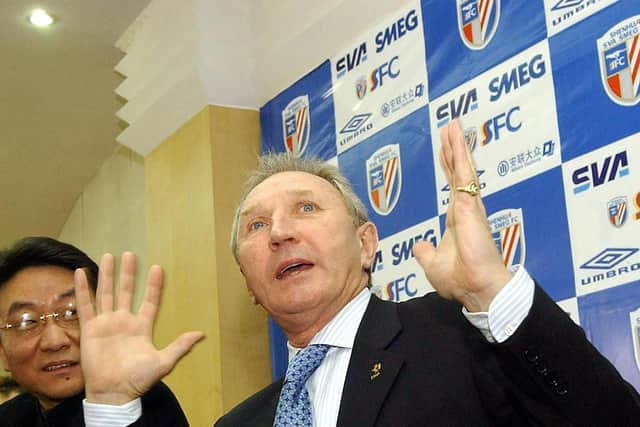Bobby Robson and tears in the boot room: The story of how Howard Wilkinson swapped Sheffield Wednesday for Leeds United
and live on Freeview channel 276
And images of Howard Wilkinson becoming the last manager to lift the First Division title a few years later have forever left a sense of ‘what it’ within the Owls fanbase.
Considering the nature of the move, Wilkinson’s swapping of top-tier Wednesday for a Leeds United in October 1988 was relatively amicable. The hugely popular Owls boss, a Wednesdayite and former player, had taken the club up in 1984 and established them as a force to be reckoned with.
Advertisement
Hide AdAdvertisement
Hide AdA fifth-place finish two years later would have seen the club qualify for the European football had it not been for English club’s ban following the Heysel Stadium tragedy.
But two creditable midtable finishes followed and the shoestring budget he had worked wonders on, a hangover from the overspending days of years gone by, had seen him take the team as far as he felt he could.
His departure is one that could have come earlier as Wilkinson weighed up his love for the club against his ambitions as one of the country’s most highly-rated managers. As has so often been central to the narrative at Hillsborough, finances were the issue.
One of his senior players saw the problem posed two years before his Leeds switch.
Advertisement
Hide AdAdvertisement
Hide Ad“By the end of my third season there, it was clear we needed to invest in better players,” he’d later admit. “We’d finished 13th in the league – eight places lower than the previous season.


“After the final game, I found Nigel Worthington sitting alone in the dressing room. ‘Gaffer,’ he said. ‘You need to leave here. You can only squeeze so much juice out of a lemon.’ I ended up staying for five years.”
Up the M1 the landscape was different. A sleeping giant with an unhealthy nostalgia for the long-gone success of the Don Revie era, Leeds were second-bottom in the second tier.
Billy Bremner, the ultimate Leeds icon and Revie’s club captain, was sacked as the club’s manager and ambitious chairman Leslie Silver was willing to flash the chequebook in an attempt to build something new. Whoever replaced Bremner would be given an exciting opportunity.
Advertisement
Hide AdAdvertisement
Hide AdBut it was a risk and Wilkinson’s own wife registered her confusion from their first conversation.


“She said I was crazy,” he said in the run-up to the 30th anniversary of the controversial cross-county switch two years ago. “A few others said the same and, to be fair, they had a point.
“My first reaction when asked if I was interested in Leeds was to reply, ‘You must be joking’. But I soon saw it as a chance to, not so much start with a clean sheet of paper, but rub the bad off the paper and keep the good.
“I liked Leslie from the start,” he said from Sheffield home. “I felt he was someone I could trust right from our first meeting at his paint company.”
Advertisement
Hide AdAdvertisement
Hide AdA seminal moment in the modern history of Sheffield Wednesday, Wilkinson had become the Leeds board’s top target only after the recommendation of the then-England manager.


He said: “Bobby Robson had recommended me for the job to Leslie and [club secretary] Bill Fotherby, his second in command. I was told via a journalist called David Walker they wanted to see me, if only to get my advice.
“So I drove up to meet Leslie at about 6.45 one night, deliberately so no one would be around.
“I had an excellent relationship with [then-Owls chairman] Bert McGee,” he adds. “He was a gentleman, but at the end of my fifth season I had gone to the board and said, ‘Look, we have gone as far as we can go with some of these players and to bring about the change required to push us on will take money’. I gave them a figure.
Advertisement
Hide AdAdvertisement
Hide Ad“The board, though, wouldn’t budge. The club had been in deep trouble a few years earlier, nearly going to the wall. The board, all Wednesdayites, didn’t want to ever be in that position again. I understood that.”
A crestfallen Wilkinson handed over his resignation to the board and became emotional when explaining his decision to staff and players. He spoke of his love of the club, his passion for football and after the thankyous and goodbyes took a moment to himself.
In the club’s empty boot room in the annals of Hillsborough’s South Stand, Wilkinson wept into a Sheffield Wednesday towel.
It was a departure sorely felt soon afterwards. Though the early 90s would prove to be halcyon days for the Owls, Wilkinson’s Whites were promoted in his first full season in West Yorkshire while his old club were relegated.
Advertisement
Hide AdAdvertisement
Hide AdWednesday would win that famous League Cup that year of course, but Leeds’ famous First Division win arrived a year later.
“There was a slow way of doing it and a quick way,” said Wilkinson, recalling his outlining of a Leeds plan that involved promotion the following season and the League title ‘within five or six years’.
“I said the difference was about £2m, which I knew from a look at the finances would have to be Leslie’s money.”
The tide changed in S6 and what Wilkinson could have achieved on the transfer kitties later handed to Ron Atkinson and Trevor Francis will forever remain one to chew over.
Advertisement
Hide AdAdvertisement
Hide AdThough he was sacked as Leeds boss in 1996, his transformation of the club from academy up put into motion an ultimately wasted legacy that would see them reach the Champions League semi-final.